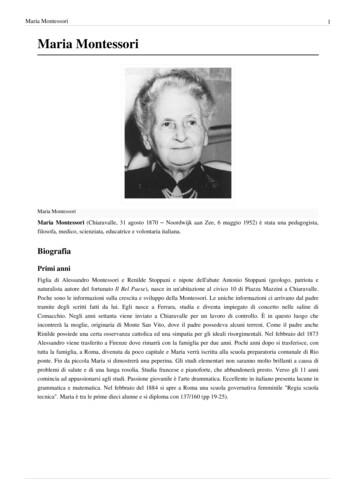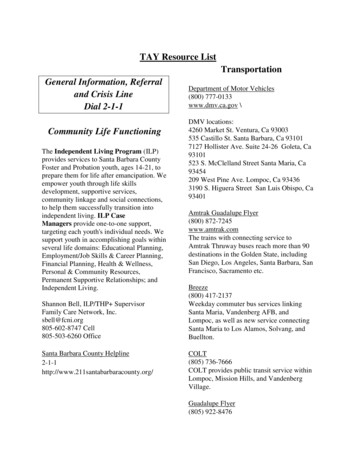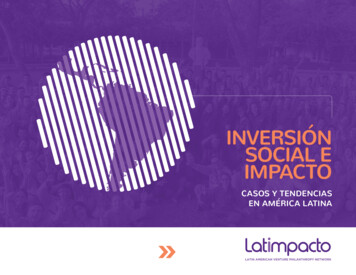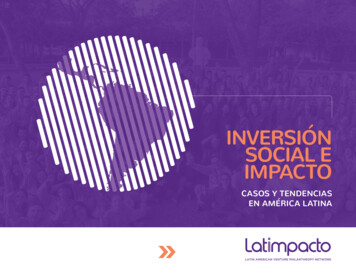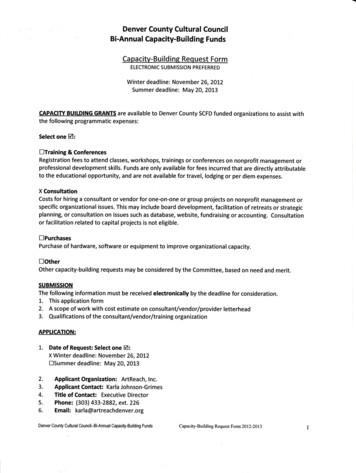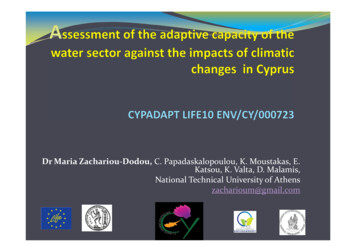
Transcription
Dr Maria Zachariou‐Dodou, C. Papadaskalopoulou, K. Moustakas, E.Katsou, K. Valta, D. Malamis,National Technical University of Athenszacharioum@gmail.com
Outline of the presentation Water sector status in Cyprus Main Climatic Factors the Projection of the future climate changes andtheir impacts on the water sector in the region Adaptive capacity in relation to the appliedMeasures in Cyprus Assessment of Vulnerability of the water sectorto the climatic changes in Cyprus
Water sector status in Cyprus (outline) Water resources are under stress Inability to meet water demands specially duringprolonged and severe drought periods Competition between sectors (agriculture, industry,residential/tourism sector) in order to satisfy their waterdemand High dependence on desalination Highest water exploitation index in Europe Lowest amount of water resources per capita Over‐stressing/exploitation of groundwater resources High Deterioration of water underground quality Increased water management costs (water transfer,operation of desalination plants, construction of dams etc)
Related Climatic Factors with Climatic changes precipitation temperature extreme events (heat waves hail, droughts, Floods) Increases in CO2 Increase in atmospheric O3 Sea level rise First 3 have an impact on the water sectorPredictions of climatic changesPRECIS regional model Eastern Mediterranean and theMiddle East (EMME)
Future Climate– RR Decreased P recipitationGradual strongest drying is expected in the easternMediterranean and North Africa: ‒10% to ‒25% in 2010‐2039 ‒20% to ‒35% in 2040‐2069 ‒30% to ‒50% 2070‐2099.Changes in the volume and timing of precipitationand evaporation will2021‐2050 it is estimated a reduction ofprecipitation only by 5% ‐ will result to areduction of 23% the total dam inflow in Cy
impacts of Decreased precipitation on the watersector Decrease in runoff More widespread water stress Reduction Water availabilityChanges in the amount of effective rainfall Decreased rates of groundwater recharge Increased water pollution anddeterioration of water quality Stalinization of coastal aquifers due poorreplenishment and to over pumping
Future Climate– Increase temperatureRegional warming1‐3 C in the near‐future (2010‐2039), 3‐5 C in the mid‐century periodJAA3.5‐7 C by the end of the centuryIncrease hot weather conditionswith 2 months additional of hot days/yearTX 35oCIncrease temperatures results inIncreases evapotranspiration ratesaffects soil moisture and Reduces infiltration togroundwater bodies
Future ‐ Increase in extreme eventsHeavy rainfall and flooding hamper water storage, resulting insignificant water losses Adverse effects in quality of surface waterand groundwater Contamination of water supply systems Lower replenishment rates in the aquifersof the mountain areas due to steep slopesExtreme Droughts Result to water deficit, and desertification Deterioration of water resources quality (salinization),
Main impacts on the water sector in Cyprus Water availability (surface and groundwaters) Water quality (surface and ground waters) Increase in frequency of Droughts Floods
Evaluation of the main impacts Indicators (impact sensitivity X exposure) sensitivity degree to which a system is affected,(either adversely or beneficially, )by climate‐relatedstimuli. exposure nature and degree to which a system isexposed to significant climatic variations. Evaluation is based on the magnitude, timing, distribution, persistence and reversibility of impacts
Indicators for the assessment of Impacts andadaptive capacity on water availability
Indicators for the assessment of Impactsadaptive capacity on water quality
Indicators for the assessment of impacts adaptivecapacity from floods
Indicator Years water demand exceed freshwaterresources
Indicator of Variability of flow into the dams of Cyprusfor the hydrological years 1987/88‐2010/11
INDICATORDecreasing dam inflowperiod 1917‐2000
Indicator of Sensitivity of runoff to precipitation changesdam inflow for the periods 1970‐2000 and 2021‐2050
Water Exploitation IndexWEIEEA, 2007Characterization 20%No water stress 20%Water stress 40 %Severe water stress
INDICATOR DROUGHTS StandardizedPrecipitation Index (quantify the precipitation deficit and theimpact of drought on the availability of the different water resources urce Bruggeman A. et al., 2011)computed for the 12 month time scale (October – SeptemberSPI Value0 ‐ (‐0,99)(‐1) ‐ (‐1,49)(‐1,5) ‐ (‐1,99) (‐2)CharacterizationMild droughtModerate droughtSevere droughtExtreme drought
Freshwater availability per capital2001‐2011 284 m/day 2021‐2050 195m/daySource: DG Environment‐EU, 2007
Water Stress Index
Water availability index Water availability index The index is normalized to the range –1 to 1. 0.0 indicates that the available water meets thedemands and a score of Cyprus, WAI is estimated to be approximately ‐‐‐0.1 for the period 2000 – 2010.
Indicator of Qualitative status of groundwaterbodies (12 saline intrusion)No of groundwaterbodySaline intrusionHigh concentrations and/orexcessCondition1YESCl, SO4, NO3, NH4,ECBAD2NO3YESCl, NO3, EC,PesticideBAD4YESCl, SO4, YES8YESCl, NO3BAD9YESCl, SO4, NO3,ECBAD10YES11YESNO3 15YESCl, NO3, ECBAD16YESCl, NO3, NH4BAD17YESNH4GOOD18NOAs, NH4GOOD19NOGOODGOODGOODGOOD
Existing situation of groundwater bodies in Cyprus (ΕθνικήΈκθεση της Κύπρου, 2008)
Indicator of the quantitative status of Groundwater bodiesGroundwater bodyGroundwater level Fluctuating4Steady‐Fluctuating5Steady or tuating‐Downward at eastern 5Downward16Downward at coastal ng
Indicator of the Ecological status of lake water bodies, (%)number of bodies (River Basin Management Plan, 2011)
Number of flooding events per year in Cyprus(1971‐2010)
Areas with potential significant flood risk inCyprus
INDICATOR Sensitivity Index to Desertification I.A.C.O. Ltd, 2007Geographical distribution of the Environmentally Sensitive Areasto Desertification I.A.C.O. Ltd, 2007
Impact of climatic changes water sectorImpact AssessmentsWateravailability fordomesticwater supplyWateravailability forirrigationWater qualityImpact (Α)in urban areasVery high(7)in mountainareasVery high(7)in plain &coastal areasVery high(7)in mountainareasVery high(7)of surfacewater bodiesModerateto High (3.9)ofgroundwaterbodiesHigh toVery high(6)FloodsModerateto High (3.4)DroughtsVery high(7)
Assessment of the Adaptation capacity of thewater sector in Cyprus Adaptive capacity the ability or the potential of asystem To adjust to moderate potential damages, to take advantage of opportunities, or to cope with the consequences of climate change. The assessment AC was based on the measurestaken The fact that Cyprus is experiencing a watershortage for the last 40 years, obliged theAuthorities to implement policies and measures tomoderate the problem
MEASURES APPLIED IN CYPRUS for WATER RESOURCES INDICATORS Measures for exploitation of freshwater resources(surface and groundwater) Measures to increase water availability Measures for the diversification of water resourcesutilization Measures for exploitation of non‐freshwater resources(Desalinated and recycling water) Measures to Regulate and decrease water demand Measures for the protection of water quality Measures to moderate the impacts from droughtsDrought preparedness plans
Adapting capacity Indicator Accumulated capacity of dams for theperiod 1958 – 2010 in Cyprus.
Adapting capacity Indicator Total water use efficiency in Mediterraneancountries (1995, 2005‐2010)Source: Plan blue, 2011
Assessment of Vulnerability of water sector toclimatic changes Despite the numerous measures implemented the adaptive capacity to cope with the consequences ofclimate change in Cyprus is to a large extend moderate The result is that the vulnerability of the water supply availability to mountain region the availability of water for irrigation, the water quality of ground water bodies and the vulnerability to droughts ARE very high or high in a lesser degree the water availability for domestic watersupply (Desalination plants) floods are considered of limited vulnerability Vulnerability Impact Adaptive capacitythe degree to which the water sector in
Vulnerability of water sector to climatic changes( susceptible to, or unable to cope with, adverse effects of climate change.)Impact AssessmentsImpact (Α)Adaptive capacity (Β)Overall vulnerability (Α‐Β)in urban areasVery high (7)High to Very high (6)Limited (1)in mountain areasVery high (7)Limited to Moderate(2)High (5)in plain & coastal areasVery high (7)Moderate (3)Moderate to High (4)in mountain areasVery high (7)Limited to Moderate(2)High (5)of surface water bodiesModerate to High(3.9)Moderate (3)Limited (0.9)of groundwater bodiesHigh to Very high (6)Limited to Moderate(2)Moderate to High (4)FloodsModerate to High(3.4)Moderate (3)Limited (0.5)DroughtsVery high (7)Limited to Moderate(2)High (5)Water availability fordomestic water supplyWater availability forirrigationWater quality
THANK YOU
THANK YOU FOR YOUR ATTENSSION
Assessment of the Adaptation capacity of the water sector in Cyprus Adaptive capacity the ability or the potential of a system To adjust to moderate potential damages, to take advantage of opportunities, or to cope with the consequences of climate change. The assessment AC was based on the measures taken The fact that Cyprus is experiencing a water

